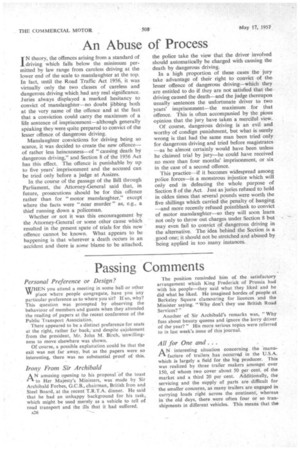An Abuse of Process
Page 28

If you've noticed an error in this article please click here to report it so we can fix it.
I N theory, the offences arising from a standard of driving which falls below the minimum permitted by law range from careless driving at the lower end of the scale to manslaughter at the top. In fact, until the Road Traffic Act 1956, it was virtually only the two classes of careless and dangerous driving which had any real significance. Juries always displayed a marked hesitancy to convict of manslaughter—no doubt jibbing both at the very name of the offence and at the fact that a conviction could carry the maximum of a life sentence of imprisonment—although generally speaking they were quite prepared to convict of the lesser offence of dangerous driving.
Manslaughter convictions for driving being so scarce, it was decided to create the new offence— of rather less heinousness—of "causing death by dangerous driving," and Section 8 of the 1956 Act has this effect. The offence is punishable by up to five years' imprisonment and the accused can be tried only before a judge at Assizes.
In the course of the passage of the Bill through Parliament, the Attorney-General said that, in future, prosecutions should be for this offence rather than for "motor manslaughter," except where the facts were ",near murder" as, e.g., a thief running down a policeman.
Whether or not it was this encouragement by the Attorney-General or some other cause which resulted in the present spate of trials for this new offence cannot be known. What appears to be happening is that wherever a death oceurs in an accident and there is some blame to be attached, the police take the view that the driver involved should automatically be charged with causing the death by dangerous driving.
In a high proportion of these cases the jury take advantage of their right to convict of the lesser offence of dangerous driving—which they are entitled to do if they are not satisfied that the driving caused the death—and the judge thereupon usually sentences the unfortunate driver to two years' imprisonment—the maximum for that offence. This is often accompanied by the pious opinion that the jury have taken a merciful view.
Of course, dangerous driving is an evil and worthy of condign punishment, but what is surely wrong is that had the same man been tried only for dangerous driving and tried before magistrates —as he almost certainly would have been unless he claimed trial by jury—he could have received no more than four months' imprisonment, or six in the case of a second offence.
This practice—if it becomes widespread among police forces—is a monstrous injustice which will only end in defeating the whole purpose of Section 8 of the Act. Just as juries refused to hold in olden times that several pounds were worth the five shillings which carried the penalty of hanging —and more recently refused pointblank to convict of motor manslaughter—so they will soon learn not only to throw out charges under Section 8 but may even fail to convict of dangerous driving in the alternative. The idea behind the Section is a good one; it should not be stretched and abused by being applied in too many instances.




























































































